
New Range Rover 2022 Review

Introduction
A new Range Rover being released is an infrequent event. Indeed, this is only the fifth new one in the car's 50+ year history.
It is hard to believe that the outgoing version has been with us for ten years already. But, in that time, technological advances – especially in terms of eco-friendliness and safety technology – have surpassed what the Range Rover was capable of.
Meet the new one, then, which aims to change its gas-guzzling reputation. But, of course, there are various other things JLR will have wanted to completely overhaul, such as the Range Rover's reputation for unreliability.
And while it feels like an age since Tata Motors bought the JLR brands, this is the first Range Rover that the firm has had an entire decade to consider.
Select's rating score* - 4.3 / 5
At A Glance
For the first time, it’s available with seven seats, too.
The untrained eye might not notice much of a difference from the front, but it's there. The bulbous front end? It is even more bulbous – smoother – with the main grille now made up of even more rows of chain bars. But they’re smaller and more modest, so it looks better.

There are hardly any bits sticking out. The front end is entirely smooth, right down to the lower portion, which is a wide rectangle with rounded edges, with the fog lights sitting on either side.
Around the side, the smoothness is even more noticeable. Apart from a modest crease at the bottom of the doors above the side skirts and the wheel arches curving out slightly, the side is flat. Even the door handles sit flush with the bodywork.
At the back, there’s another rectangle made up of an outline of blackened bodywork, but unlike the one at the front, this one is much taller, fitting the number plate in the middle. At the same time, the Range Rover lettering sits on its top border, which doubles up as a light bar for the dynamic indicators. Again, apart from the number plate area, where there's an indentation, the bodywork is smooth.

It gives off a minimalistic and simplistic feel yet looks sleek, sophisticated, modern and inspiring. And it still looks unmistakably like a Range Rover.
It looks incredibly similar to the last Range Rover, just that it's been given some updates to align with modern-day fashion trends, and, with those subtle tweaks, it looks marvellous.
Every single panel is new. You need to see the old one and the new one side by side to truly appreciate the subtle yet significant changes.
Key Features
The Range Rover is built on a brand-new MLA-Flex chassis, mainly made from aluminium but much more robust than its predecessor.
There are two variants: standard and long-wheelbase, plus four trims.

The SE gets 21-inch wheels, pixel LED headlights, a fixed panoramic roof, a 13.1-inch Pivi Pro touchscreen with Amazon Alexa and wireless Apple CarPlay/Android Auto. There is also a wireless phone charger, three-zone climate control, all-wheel steering, electronic air suspension, a 3D surround camera and 20-way heated electric front seats with power-reclining heated rear seats.
The HSE gets 22-inch alloys, digital LED headlights, a head-up display, a 3D surround sound system and park assist, as well as illuminated seat belt buckles.
The Autobiography trim gets a solar attenuating windscreen, a sliding panoramic roof and laminated front and rear side glass, as well as Autobiography styling details on the exterior.
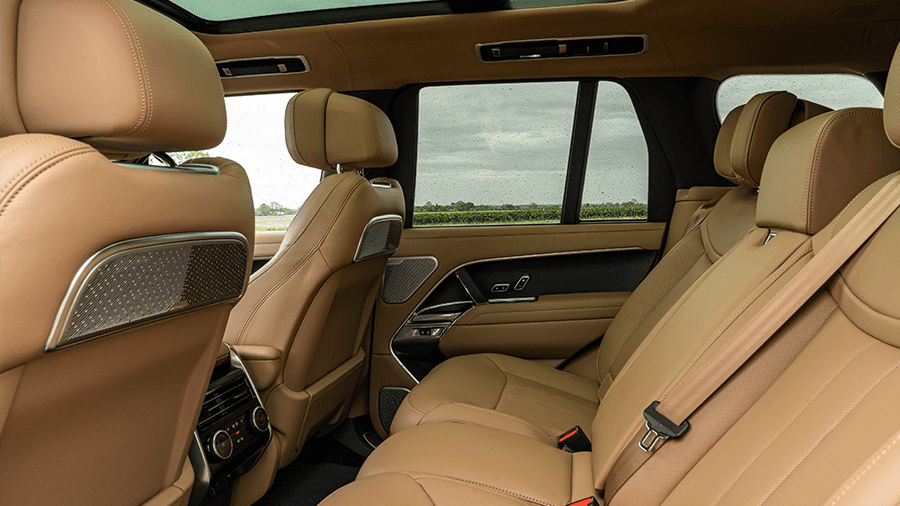
The SV trim gets various styling elements, including exterior accents, metal-plated details, SV-styled front bumper and grille and exterior badging.
The standard-wheelbase is available with SE, HSE, Autobiography, First Edition and SV trims, while the long-wheelbase version is only available with Autobiography, First Edition and SV.
The seven-seater is only obtainable with the long-wheelbase, though it gets a choice of SE, HSE or Autobiography trims.
There are also four power trains to choose from, all but one of which are based on 3.0-litre turbocharged engines.
The P440e and P510e are both plug-in hybrids, which combine a petrol engine and an electric motor, producing 440 and 510PS, respectively. The two diesels are mild hybrids – the D300 produces 300PS, while the D350 produces 50PS extra. There is also the P400 mild hybrid, which is a petrol, producing 400PS.
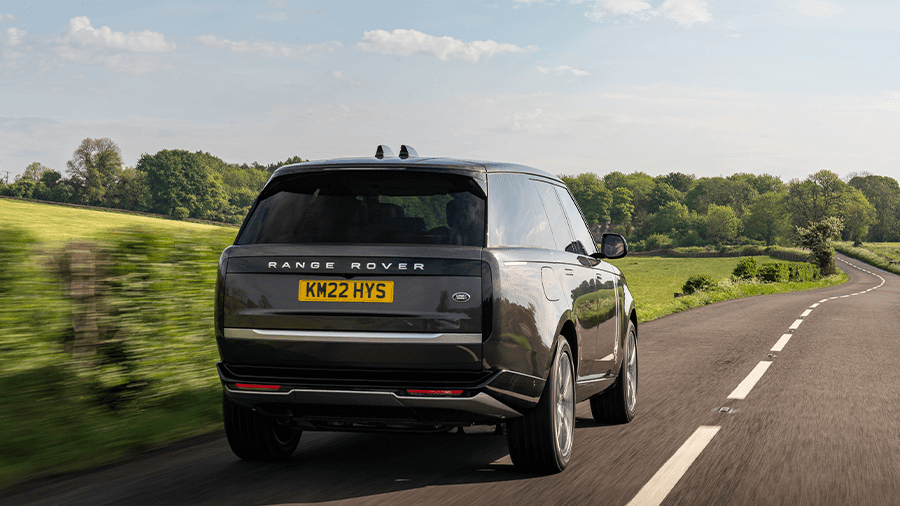
The one exception to the above is the non-hybrid P530 which (you guessed it) produces 530PS and is a 4.4-litre V8 twin-turbocharged petrol.
One thing to note is that not all engines are available on all trims. For example, the seven-seater is only available in the long-wheelbase version, and if you choose the seven-seater, there's no plug-in hybrid available.
Performance & Drive
If you fear the diesel might be a bit tractor-like, the D350 is anything but. It is superbly quiet and refined, meaning you don't notice you're driving a diesel often – and it provides good low-end torque off the line. Ironically, when flooring it, you can tell it's a diesel, but if you want to forget about that, then the performance offers a good distraction.
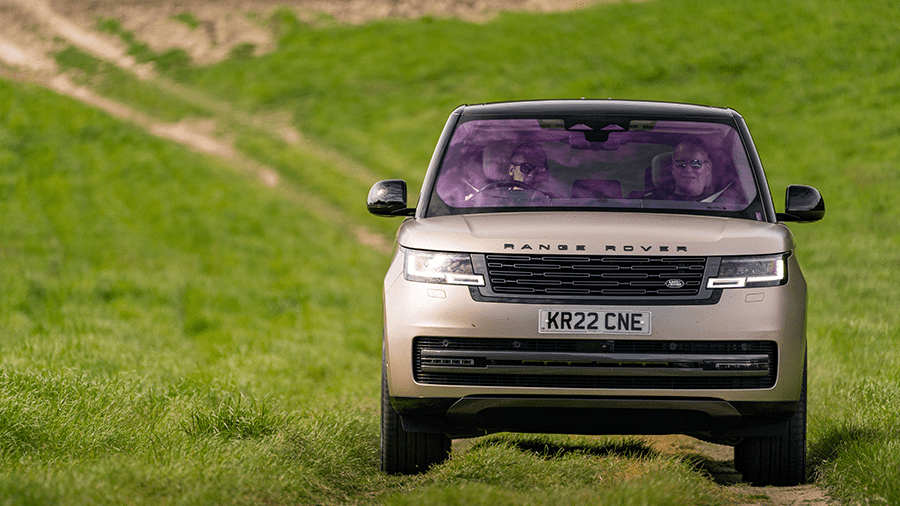
The P530 is a right laugh, providing maximum grunt that gets you to 62mph from a standing start in little more than four-and-a-half seconds. It throws you back in your seat when you floor it off the line, and it is great fun. Although, given how impressive the diesel is, you must question whether you need all that extra power.
In all conditions, the Range Rover feels at home. Of course, around town, it’s a bit big to be threading it through traffic on ring roads and, for many situations, it's simply overkill due to its size. But take it on a motorway, and it's perfect. All engines accelerate well from 50mph to 70mph, and overtaking is a doddle.
The eight-speed automatic gearbox fitted across the range changes responsively and smoothly. Even on optional 23-inch wheels, we were pleasantly surprised at how comfortable and forgiving the ride was.
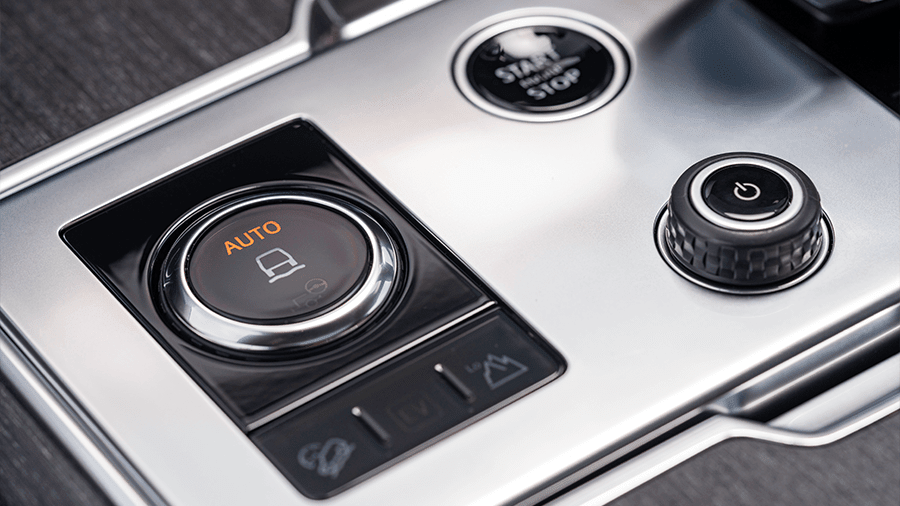
It is excellent and absorbing in all conditions thanks to the active air suspension, but gives enough feedback that you can easily judge the state of the road surface. At the same time, the car automatically scans the road ahead to brace the suspension for what's coming next. Based on what we witnessed, it works superbly.
It has keen handling for an SUV, though don’t think this means it’ll manoeuvre as well as a sports car. Body roll is controlled well in the corners – and markedly improved on its predecessor – and there’s plenty of grip, too.
But the Range Rover is too big and has too high a centre of gravity to be thrown around bends. You can put the Range Rover into Dynamic mode, which sharpens things up. And it has all-wheel steering of up to a seven-degree rotation at the rear – but the reality is the push of a button can't magic a big SUV into a hot hatch.
The steering is light, arguably a bit too much for thrill-seekers, but this isn't what the car is about, despite an improvement in its all-around drivability.
It is a step up in sophistication. Whereas before, the likes of BMW or Audi could hold a candle to it, the Range Rover now properly bridges the German premium brands and the likes of Rolls Royce for refinement.
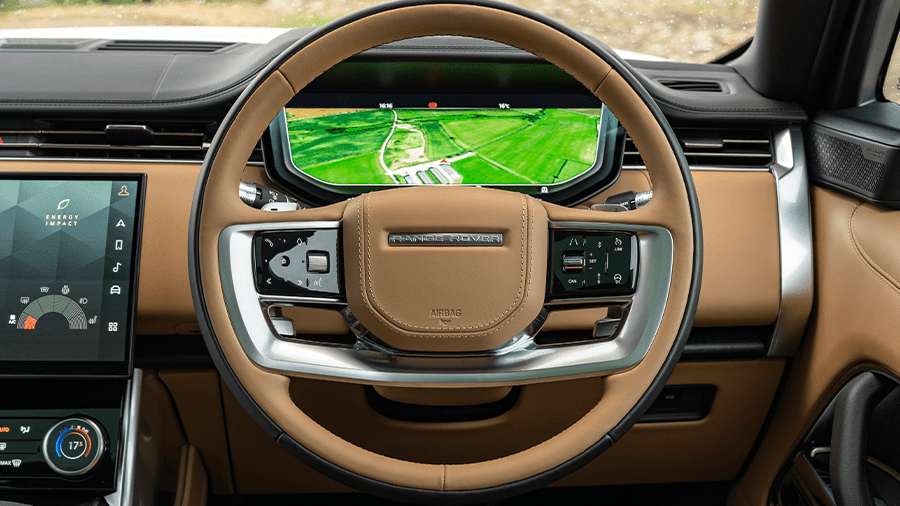
Road and wind noise is limited by noise cancellation, which works via the Meridian sound system.
Of course, you can't review a Range Rover without taking it off-road, and we're pleased – and unsurprised – to report that it is brilliant on the rough stuff.
It will set itself up automatically, though you can override it and choose your Terrain Response settings. But the chassis is well-tuned, and it's a joy to drive around an off-road course, where we will happily admit to having rather too much fun.
Press a button to engage the low-range gearbox, and the car takes care of everything else if you're not an off-road specialist. In total, we drove it for around five hours and didn't feel drained at the end of our road test. On the contrary, the whole experience was sublime and relaxing, apart from our childish tomfoolery driving through a swampy area.
The plug-in hybrid isn’t arriving for a while, but there's nothing wrong with the diesel. You hardly notice it’s a diesel, it's got more low-end grunt than the petrol, and it's not that much slower than the V8 petrol.
In any event, the Range Rover is outstanding.
Running Costs & Emissions
The plug-in hybrid claims fuel consumption of 333.8mpg, producing just 19g/km of CO2, making it a company car driver’s dream.
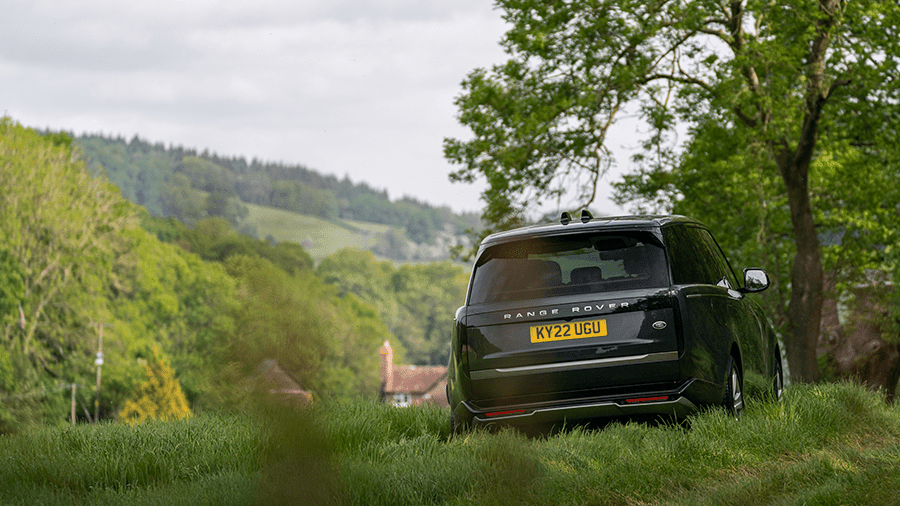
For the diesels, the D300 can manage 36.7mpg, producing 202g/km of CO2, with the D350 only slightly worse off at 36.5mpg and 203g/km of CO2.
The petrols measure in at 29.3mpg and 218g/km of CO2 for the P400, while the big P530 manages 24.3mpg, producing 264g/km of CO2.
These figures are for the standard-wheelbase version. In the long-wheelbase version, the figures are comparable but slightly worse.
Road tax will be very high unless you pick the plug-in hybrid, and don’t expect running costs to be cheap either – a full service will easily be north of £500. Make sure you've got protection for your services by taking a look at our servicing and maintenance packages guide.
Interior & Technology
Much like the exterior, the interior retains a Range Rover-like feel while being simplified and minimalistic.
Apart from the 'hood' over the top of the digital dials, the dashboard is flat and made up of horizontal lines. A tablet sits on the dashboard to the right of the steering wheel. But it isn't bolted on top like in some cars, though that's a good thing bearing in mind the high driving position, as you'll be looking down at the road.
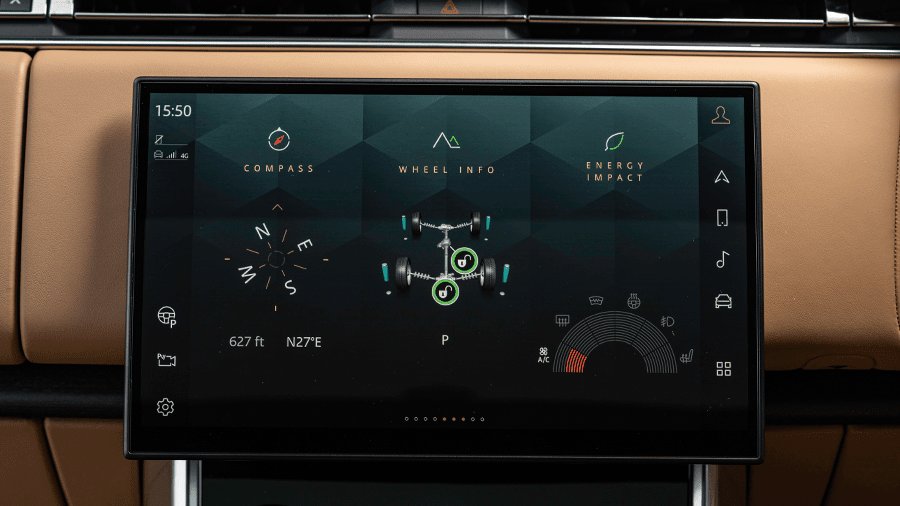
The 13.1-inch Pivi Pro infotainment screen is ever-so-slightly curved, and the system is clear, crisp, intuitive and easy to use. It isn't quite on the level of BMW's unit, but it gives it a good run for its money. We didn't like the haptic feedback, but thankfully, it can be turned off.
Happily, there are still physical dials for the climate control system, while the gear selector is on the small side and requires a push of a button at the back of the lever to operate it. However, we did find it moves a little too easily, with none of the resistance you'd find with a conventional automatic gear lever.
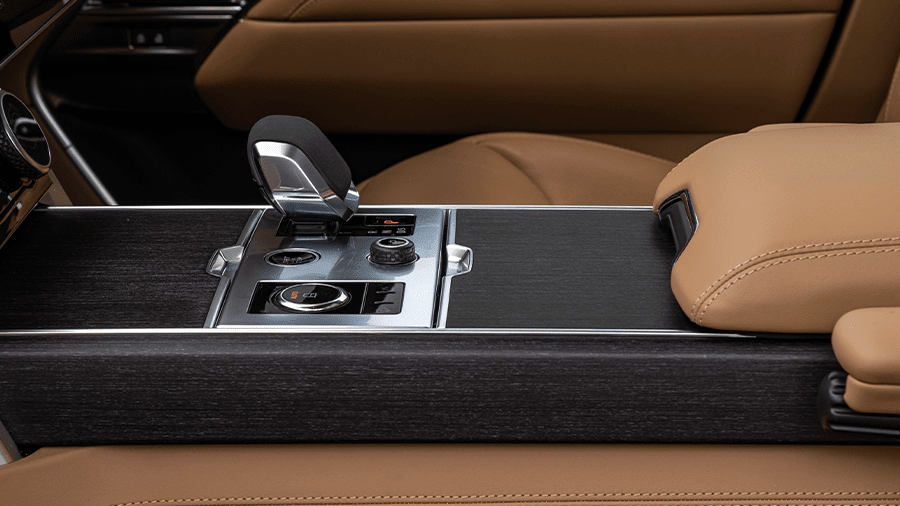
If you want the height of luxury, then go for the SV edition with Signature Suite. It turns the Range Rover into a work of art, offering a four-seater version with larger massage seats, a motorised table that rises out of the centre console and a fridge whose door closes by itself.
These features are unlikely to be seen by most Range Rover drivers, who will no doubt opt for five or seven seats. But the sheer attention to detail makes you realise how badly JLR want this car to succeed.
The doors can detect potential hazards such as cyclists and kerbs, while the driver's door can shut itself on command. At the same time, the voice assistant is provided via Amazon Alexa and works well.
Overall, the interior is an improvement from what came before. It is arguably class-leading, and it's tough to find fault with it.
Practicality & Boot Space
Practicality is the name of the game.
There is lots of storage space inside, including room by the gear lever for your phone to be charged wirelessly, while the centre console cubby is capacious.
There is a load of headroom and legroom in all seats, while, in the long-wheelbase seven-seater, there's still a decent amount of room in the rear seats. But they aren't as comfortable for longer journeys as the knee room is slightly limited if you're taller.
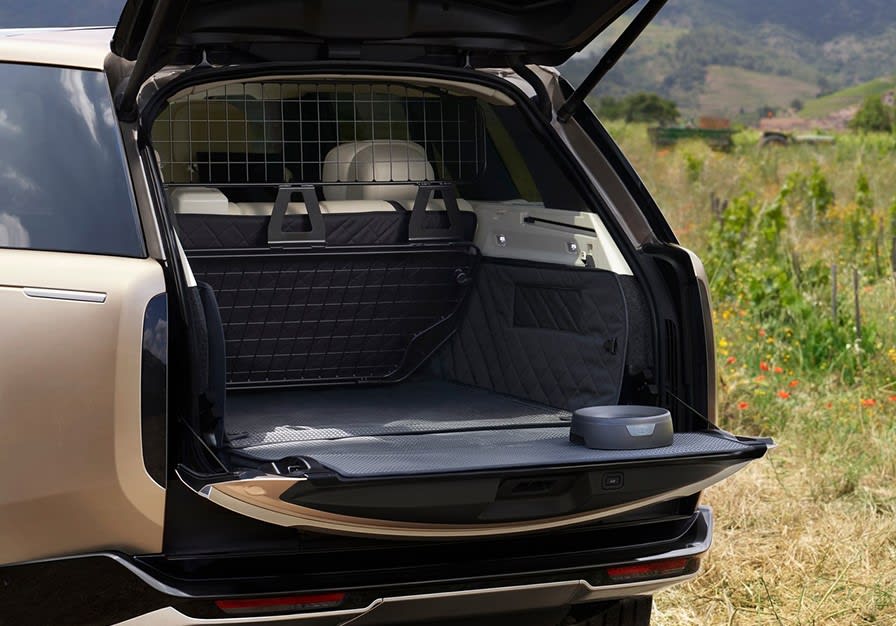
In the long-wheelbase version, boot space with all seven seats in place is 312 litres, though the rear chairs fold flat into the floor, increasing the capacity to 1,061 litres. Fold-down the middle seats, and you'll have a whopping 2,601 litres at your disposal.
The standard-wheelbase version has 1,050 litres of boot space, while the back seats fold away to increase this to 2,335 litres.
.jpg)
Safety
Euro NCAP hasn’t yet safety tested the new Range Rover yet, but Land Rover hasn't scored less than a five-star rating since 2006, so we're not worried.
All models include emergency braking, blind-spot assist, a 3D surround camera, adaptive cruise control with steering assist and driver condition response (which warns if it thinks you're not paying attention).
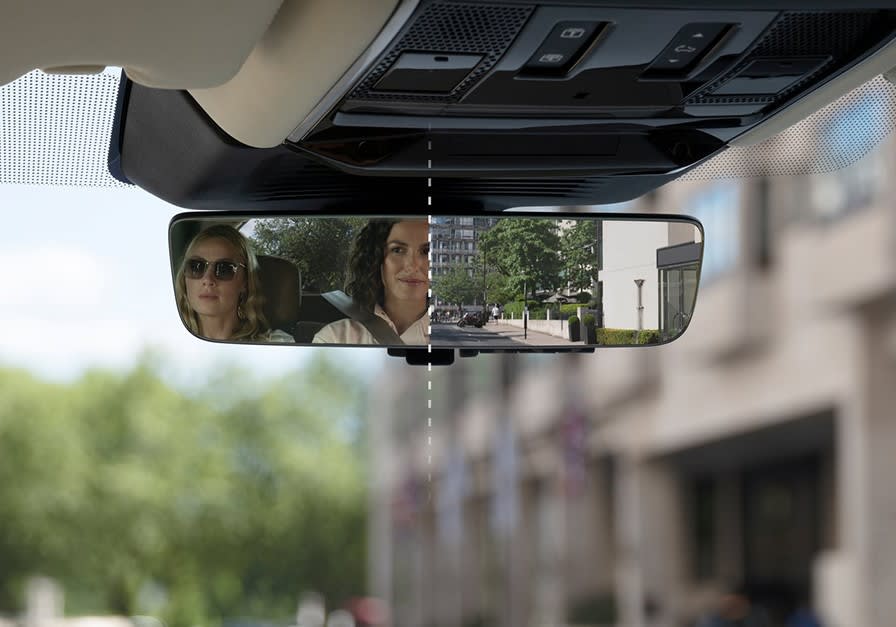
You also get lane keep assist, front and rear parking aids, rear collision monitor, rear traffic monitor, traffic sign recognition and adaptive speed limiter and occupant protection assist. This feature shuts the windows and closes the panoramic roof if it detects an imminent collision.
Autobiography trim and above gets Park Assist, too.
Options
A few exterior packs, Nickel Atlas, Shadow, and Autobiography, provide various styling details.
You can have 23-inch wheels if you want, though a downgrade to as low as 20-inches is available for those who want the extra comfort, with a range of alloys to choose from.
Other extras include a side step kit, roof racks, storage solutions, a dashcam, snow chains, configurable cabin lighting, heated armrests and a fridge.
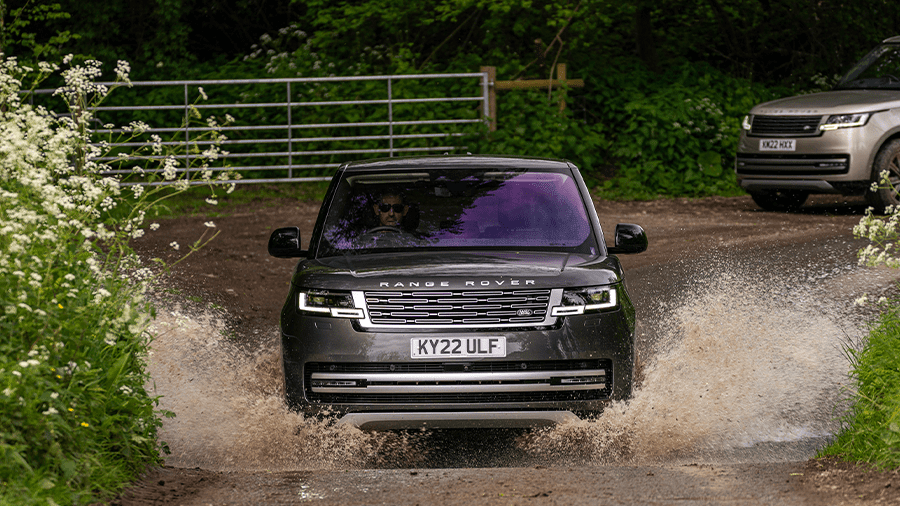
Rival Cars
Your alternatives will likely be a BMW X5 or X7 and an Audi Q7.
That said, if you're in the market for a Range Rover, then it's likely you want a Range Rover and nothing else – so possibly none of its rivals will suffice.
The Range Rover Sport is the obvious alternative if the leasing cost is too much. However, the Land Rover Discovery, and the Discovery Sport, are also well worth considering depending on your budget.
Other than its sister cars, there isn't an SUV on the market that properly compares with a Range Rover.
If you can afford a higher spec model, though, then you’ll be approaching the price points of a Bentley Bentayga or Lamborghini Urus.
A Rolls-Royce Cullinan is an obvious alternative for the very well-off, though all three of the aforementioned have very different personalities.
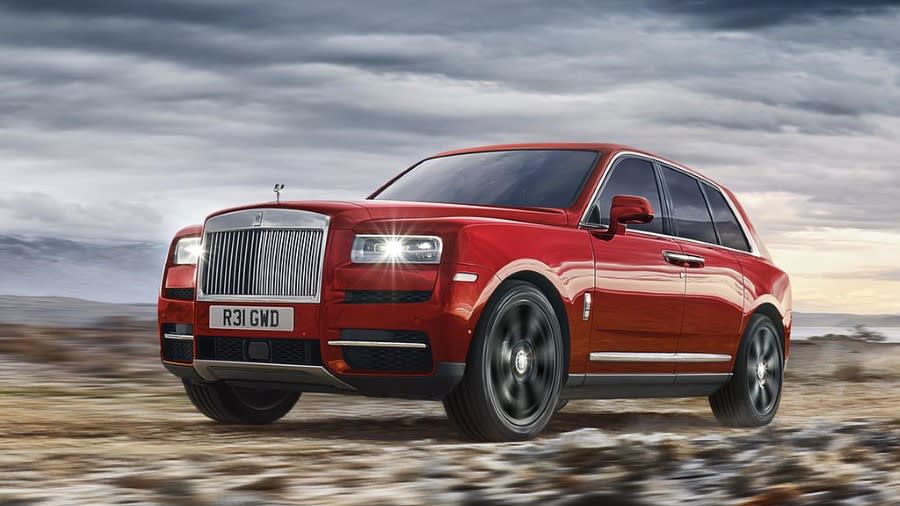
Verdict & Next Steps
The new Range Rover is brilliant.
Utilising the best of British automotive engineering, it’s a car that's leaving its rivals in the dust. It is repositioning itself as something closer to the ultimate luxury brands of Rolls Royce rather than the premium brands of BMW and Audi.
It doesn't have the handling of a Lamborghini Urus, but it's not trying to be something it's not. Instead, the Range Rover is a car that doesn't need to compete with anything else – it firmly defines its path, knowing that those with deep pockets will come clamouring for it.
Indeed, in less than 20 years, the Range Rover has more than doubled in price, pushing it into the territory of being super-exclusive.
JLR’s defence is that its range has expanded considerably, with the Land Rover Discovery, Discovery Sport, Range Rover Sport, plus the Velar and Evoque, offering those less well-endowed the chance of getting on the JLR SUV ladder.
All things considered, though, it deserves to be a pricey car. It is better than its predecessor in every conceivable way. It offers staggering attention to detail, modern looks, an outstanding interior, good drivability and performance, plus off-roading capability that’s unmatched, except for one or two of its siblings in the JLR stable.
It is no surprise that the Range Rover is still King of the Hill.
The real surprise is just how wide the chasm is that its competitors must now attempt to close.
Where to next?
View our latest Range Rover lease deal - from just £1,001.36 per month inc VAT**
Looking for a great leasing deal? Check out our incredible range of Special Offers
New luxury SUV? Read our latest Car Reviews and find the right model for you
Want to know more about leasing? Take a look at our comprehensive Leasing Guides
Interested in everything motoring? Why not catch up on all the latest Car Leasing News.
*Score based on Select’s unique meta score analysis, taking into account the UK’s top five leading independent car website reviews of the Range Rover
**Correct as of 12/07/2022. Based on 9 months initial payment, 5,000 miles over a 36 month lease. Initial payment equivalent to 9 monthly payments or £9,030.87 Ts and Cs apply. Credit is subject to status.






















